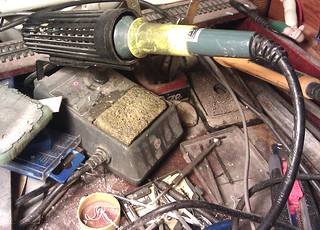 Right, before I crack on with the Thornycroft, a quick lesson on soldering whitemetal.
Right, before I crack on with the Thornycroft, a quick lesson on soldering whitemetal.Low-melt soldering scares the heck out of people. The concept of poking hot soldering irons into a material with a low melting point is scary. Magazine articles frequently mention kits being reduced to puddles when the author wants to explain why they are using glue, or just wishes to embue his text with an air of machismo.
There is one thing to remember: low-melt solder melts at a lower temperature than the castings you are soldering together.
Thus, your iron can be set at a temperature low enough to let you poke a casting with it but still hot enough to make molten solder.
You'll need a temperature controlled iron of course. Mine cost me a tenner from Maplin although it's normally 20 quid. The pointy bit it came fitted with was replaced with one of their spares (costing half as much as the iron!) and all is well. Dial the temperature in to about a third of the range, let it warm up and then poke the back of a casting with it. If nothing bad happens then the iron is cool enough.
 Then poke the solder. If this melts you're good to go. If not tweak up or down until you find the happy temperature.
Then poke the solder. If this melts you're good to go. If not tweak up or down until you find the happy temperature.Talking of solder, I buy mine in big bags from Langly Models. They will sell you flux too but I prefer Powerflow from the DIY store. Admitedly 'cos it lives on the bench but since it works, then this is good too.
Apart from that, low-melt soldering is the same as the higher temp stuff. Put the bits together, smear flux over the joint, pick up solder from the end of the stick and work it into the joint with the iron. Blow on the join to cool it off and you're good. Low melt does take longer to cool to hard than hig temp. Someone who does physics can explain that perhaps.
Not so scary after all.
Notes:
Very small castings can absorb less heat than bigger ones so be careful poking them with a hot iron.
You will read people soldering low-melt with normal irons. It can work if you are confident, quick and work with big lumps of metal. Get a temperature controlled iron and don't be silly.
1 comment:
Phil,
Thanks for your post on working with white metal castings and in particular using a temperature controlled soldering iron. There is, of course, a far bigger risk than melting those precious bits of white metal. 70 degree low metling point solder, aka Wood's Metal, contains cadmium. This element is toxic more to the point carcinagenic. The solder must not be heated above 250C and ideally the temperature of the solder should be kept down to 120C. For more info please see the data sheet at the link below.
(NB I have no connection nwith Tiranti's)
Keep up the good work with your blog.
Regards,
Tanllan
Post a Comment